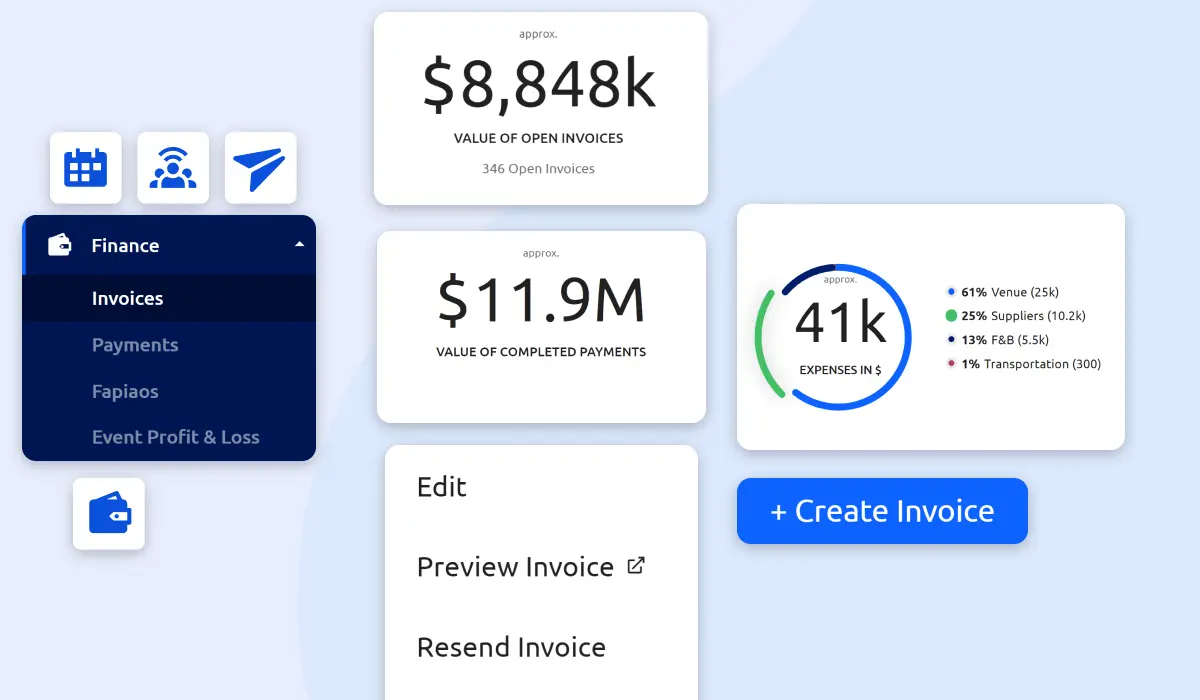
ROI, or return on investment, is a key metric to calculate the value generated by your association. When you know how to find ROI, you can see whether you're investing funds wisely in projects that benefit your members.
In this comprehensive guide, we'll explain the formula and show you some examples of ROI to illustrate why it's important for your association.
Key Takeaways
- ROI helps assess the value generated by association projects and investments.
- Basic ROI calculation: Divide total benefit by the initial cost of an investment.
- A good association ROI generally ranges from 50% to over 100%, depending on various factors.
- ROI has limitations, not accounting for intangible benefits or long-term objectives.
- Strategies to boost ROI include member surveys, technology investment, and personalized experiences.
What Is Return on Investment (ROI)?

ROI shows how much value you've created from a specific investment based on its initial cost and its total net benefit. You can measure ROI to see if a project was successful and determine whether to continue it.
ROI can look at the value of just one part of your association or examine the overall benefits your organization creates for its members.
Why Is ROI Important for Associations?
ROI can illustrate the value created by each of your association's expenses. You can find the ROI of various projects, departments, and investments so you can more effectively manage resources.
These are just a few examples of how you can use this calculation to benefit your association:
- Deciding how much to invest in new member benefits
- Determining whether to launch a new program or service
- Calculating the potential return from an investment in new technology
- Pricing your membership tiers appropriately
- Seeing if a marketing campaign was effective
- Determining whether it makes financial sense to hire additional staff
- Evaluating the success of conferences and events
If you plan to seek funding or partnerships for your association, you'll need to prove its positive ROI to potential investors or collaborators.
How to Calculate ROI for Associations
To calculate ROI, simply divide the amount of benefit from an investment or project by its original cost. Let's look at a basic example to see how it works.
Imagine you started a new professional development program for your members with $10,000 in initial costs.
Through this investment, you provided training to 100 members who each reported an average of $200 in increased earnings, for a total benefit of $20,000. When you divide $20,000 (benefit) by $10,000 (original cost), you get an ROI of 2. You can also express this number as 200%.
You can also find the ROI of your entire association. For this calculation, divide the net benefit to members by the total cost of running the association.
For example, if you've generated $1,000,000 in member benefits from $500,000 in expenses, your association's ROI is 2, or 200%.
What Is Considered a Good ROI for Associations?

What is a good ROI? That's a tricky question to answer.
The target ROI number varies significantly depending on the type of association, size of your organization, type of project or investment, and other factors.
In general, members want to see a positive ROI before joining or renewing their membership. That means if your association provides $250,000 in member benefits, it should have less than $250,000 in expenses to attract and retain members.
If you find the benchmark ROI for parts of your association, you can track this metric over time and make adjustments as needed.
You can also use these hints to get an idea of the target return for your association:
- 0-50% ROI: This may indicate a need for improvement in member benefits or cost reduction
- 50-100% ROI: A solid return that shows members are getting value for their investment
- 100%+ ROI: Excellent value proposition, likely to attract and retain members
Remember that ROI can vary depending on how actively a member engages with the association's offerings. It's a good idea to calculate ROI for different member personas or engagement levels.
The Pros and Cons of Using ROI for Associations
Benefits of Association ROI
ROI provides easy-to-understand information about value creation with one quick calculation. You only need a few basic numbers to get an idea of whether your investment will benefit your members.
It's also one of the most flexible metrics for association leaders. You can find the value generated by the entire organization as well as the benefit derived by each of its components.
Potential Drawbacks of ROI
ROI earns points for simplicity, but it doesn't account for factors that could affect value creation. Examples include:
- Your association's long-term objectives
- Intangible benefits like networking and professional growth
- The time expense associated with an investment
- The longevity of an investment
- Member satisfaction and engagement levels
More complex methods of calculating ROI do consider these complications.
They can also predict the future return on an investment expected to benefit the association over several years, like a new membership management system (MMS) or a long-term advocacy initiative.
As mentioned above, it can also be difficult to determine whether a given ROI is "good" in a particular situation. You'll need some experience with this number to see how it rises and falls for your association.
ROI can be a particular challenge if you want to determine the value of investments with qualitative returns, such as improved member satisfaction or enhanced industry reputation.
Strategies to Boost Your Association's ROI and Membership Value

Now that you understand how to calculate your association's ROI, let's explore strategies to improve it and enhance your membership value:
Conduct Regular Member Surveys
Regularly survey your members to understand their needs, preferences, and pain points. Use this information to tailor your offerings and improve your value proposition.
Invest in Technology
Take advantage of technology to streamline operations, improve member engagement, and offer new digital benefits. Consider implementing a robust association management system (AMS), mobile apps for easy access to resources, or virtual event platforms for increased accessibility.
Enhance Educational Offerings
Provide high-quality, relevant educational content that helps members advance their careers. Develop certification programs, offer micro-credentials, or create on-demand learning modules.
Expand Networking Opportunities
Facilitate meaningful connections among members through virtual and in-person networking events, online communities, or mentorship programs.
Strengthen Advocacy Efforts
Amplify your association's voice in policy matters by engaging in targeted lobbying efforts and providing regular policy updates to members.
Develop Strategic Partnerships
Form alliances with industry partners to offer exclusive discounts and benefits to your members.
Personalize Member Experience
Use data analytics to tailor the member experience with personalized content recommendations and customized event agendas.
Focus on Career Advancement
Help members progress in their careers by offering job boards, resume review services, or leadership training programs.
Improve Communication of Value
Effectively communicate your association's ROI to members through annual value reports, success stories, and infographics.
Continuously Innovate
Stay ahead of association trends and member needs by forming an innovation committee and regularly evaluating and updating your programs.
The Bottom Line
ROI offers a smart starting point to evaluate the value creation of your association, especially if you're new to analyzing your organization's finances. However, when you use this metric to assess your operations, it's important to understand its limitations.
For best results, combine ROI with other measurements to get a more accurate picture of your association's health and the value it provides to members.
By focusing on calculating and improving your ROI, you can create a thriving association that consistently delivers tangible benefits to its members. Remember, ROI is not just a number—it's a reflection of your association's commitment to providing value.
Regularly assess and communicate your ROI, and always look for new ways to enhance the member experience. With a strong focus on ROI and member value, your association will be well-positioned to attract new members, retain existing ones, and make a lasting impact in your industry.



